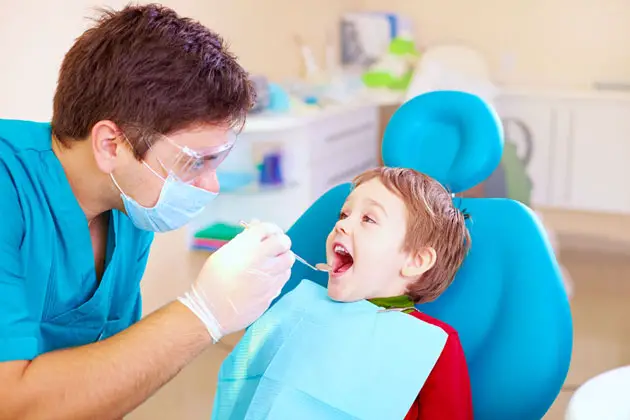Your guide to various dental procedures kids may encounter, plus tips to keep your kids’s teeth healthy
It’s no secret that many children are scared of going to the dentist, a fear that is unfortunately often reinforced by dentists’ portrayal on TV shows and in pop culture—as well as by many grown-ups’s own reactions to the twice-yearly need for dental checkups.
For sure, visits to the dentist can be confusing, for kids and parents, coming as they do with an array of procedures and terminology, not to mention equipment and instruments that are all unique to the dentists’ and orthodontists’ offices. In that spirit, we spoke with several area pediatric dentists and orthodontists in an effort to demystify visits to their offices and explain what goes on there and why these procedures are so important.
“Children fear the unknown, and are often misinformed about the dentist,” says Marc Adelberg, D.D.S., who practices at Adelberg Montalvan Pediatric Dentistry, which has three locations on Long Island. “We understand that what we do impacts the child’s life forever, so we try to make things fun and inviting for them.”
Since February is National Children’s Dental Health Month, here’s a primer to what generally goes on when kids visit the dentist and orthodontist.
RELATED: Find dental providers near you
Routine Dental Exams
Routine dental exams are evaluations that gauge your child’s overall dental health. At the exam, the dentist (and/or hygienist) will clean your child’s teeth, review the technique for how she should be flossing and brushing, discuss oral hygiene generally, and apply topical fluoride treatment, which is a delivery of fluoride minerals to the teeth to help protect them from cavities. At some visits, the dentist will take X-rays.
Checkups can address potential problems in your child’s mouth early so she’ll need minimal treatment or interventions when she’s older. Children, like adults, should have routine dental exams every six months.
“Bad brushing habits and hygiene habits can all be taken into account,” Dr. Adelberg says. “Parents should get them to the dentist early so we can help treat and coach them at an early age.”
X-rays
X-rays are screenings that take images of your child’s mouth on each side. They provide a close-up view of your child’s jaw and tooth structure, and can reveal weaknesses such as cavities and demineralization, which is the reduction of mineral substances in the teeth. X-rays provide a view of your child’s mouth that normal eyesight can’t provide, according to Rania Elbaz, D.D.S., who practices at Merrick Pediatric Dentistry in Merrick. “Bite-wings, occlusal, and panoramic X-rays take images of the child’s mouth from front to back, including the molars,” Dr. Elbaz says, referring to three different types of X-rays. “These X-rays can evaluate a child’s bite and even identify jaw abnormalities.”
Your child’s teeth push closer together as they grow, making them more prone to cavities as more plaque accumulates between the teeth. When your child is 2 or 3 years old, dentists will take X-rays of his mouth to help track the teeth’s progression.
Sealants
Sealants are thin, white plastic coatings that are placed at the tops of the chewing surfaces of the back teeth to help prevent tooth decay. The groves and chewing surfaces of the teeth can accumulate plaque, since they’re the most susceptible to cavities in children and teens. The protective coating offered by sealants is recommended for kids ages 6-8 for the first set of molars and ages 12-14 for the second set of molars.
Fillings
Fillings are composites that are placed in the weakened mineral deposits of one’s teeth to help prevent cavities or fill the holes when cavities occur. Fillings can prevent the teeth from decaying further by blocking bacteria from entering the teeth. They can also be used to restore teeth for cosmetic purposes by giving them the appropriate shade of color that matches one’s teeth.
Extractions
Extractions are used to either facilitate other procedures in a crowded mouth or to remove a tooth that is beyond saving. Extractions can also be necessary to correct jaw spacing or provide the room necessary for braces. Every child’s mouth is different, says Glen Ehrenman, D.D.S., who practices at Ehrenman & Khan Pediatric Dentistry in Westbury. “Kids are evaluated each time they come in with growth and development, but everyone grows and develops at their own pace.”
Pediatric dentists will evaluate your child’s mouth to see if she needs any extractions. If your child is anxious about the procedure, dentists can offer the option of sedating your child through the extraction.
Laser Treatment
Laser treatment is a method of handling delicate procedures in children as young as 2-3, such as cavities and lip ties, which happen when the upper lips of infants are tethered to the upper gums from birth. The laser can remove tooth decay without touching the tooth, and it also numbs the tooth as an added bonus for your child’s comfortability. Laser treatment is not a common treatment, and only select offices have this equipment.
Renuka Bijoor, D.D.S., who practices at Briarcliff Pediatric Dentistry in Briarcliff Manor, says laser technology is her practice’s most utilized procedure tool. She explains that it can be used in multiple procedures in children without instilling any trauma like anesthesia shots. For example, dentists can use laser treatment in place of the conventional drill when treating cavities, eliminating the need for anesthesia shots and making your child’s experience the least invasive and painful as possible.
“The experience is shorter and much less dramatic,” Dr. Bijoor says. “It gives the patient a healthy experience and prevents the fear of the dentist from developing early on.”
Braces
Braces are used for aligning crooked teeth and to help position someone’s bite. Wires are attached along the teeth to align them slowly over time causing minimal discomfort. Pediatric dentists evaluate kids’ mouths to decide if braces may be required, while an orthodontist will make the decision and do the work of installing braces. The wires on the braces are tightened to adjust teeth every four to six weeks, and children can wear them for two to three years on average.
RELATED: Tips to Keep Kids’ Teeth Healthy



















